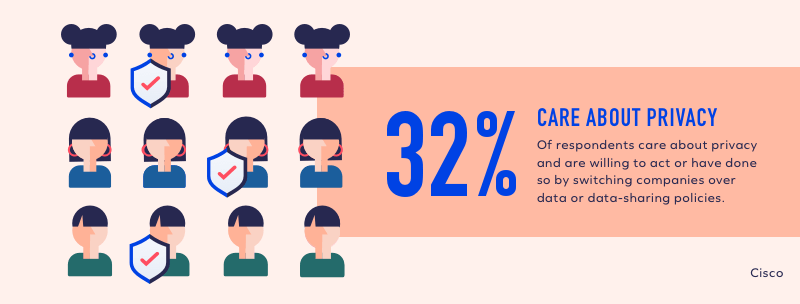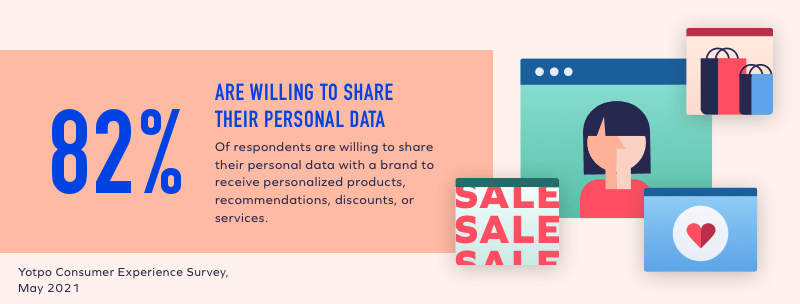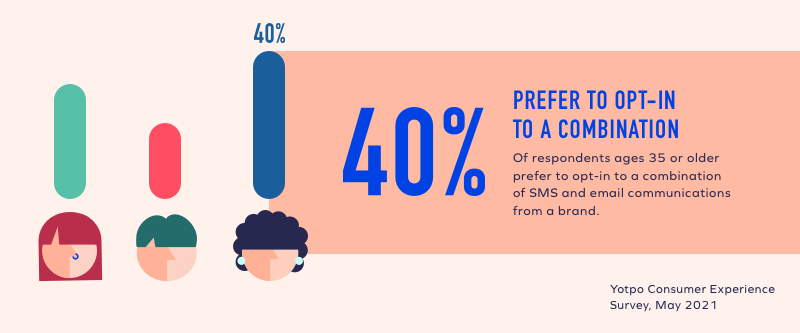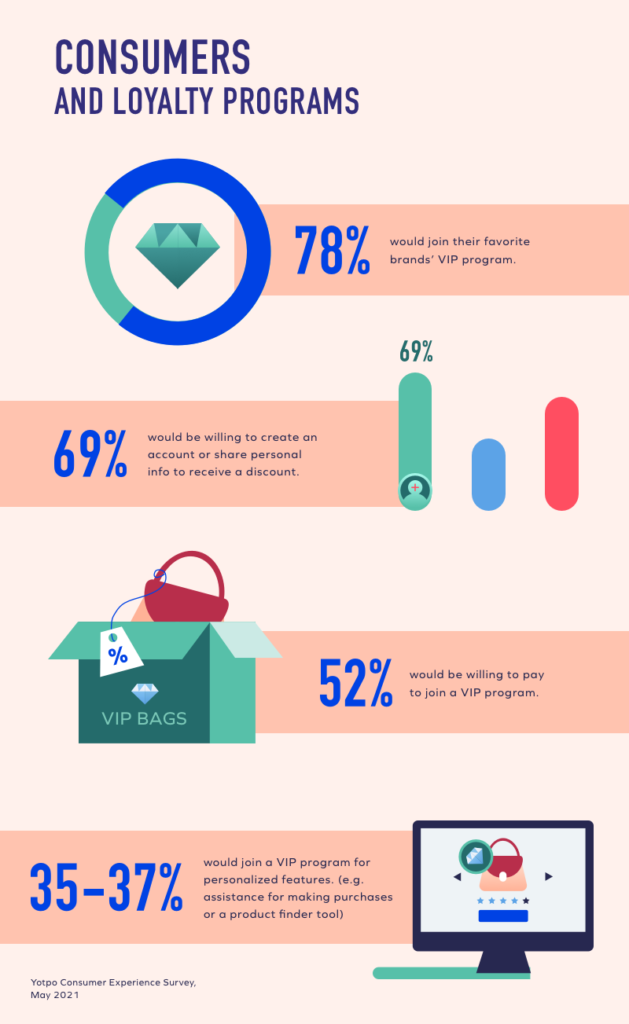In the past several months, the world of eCommerce has been confronted with an unpredictable host of challenges that could forever change the way that digital brands do business. Playbooks are being rewritten, budgets are being adjusted, and strategies are being redeployed.
Of course, we’re not talking about the pandemic, but the vast privacy overhauls taking place around the world — with states, countries, and major tech companies like Google and Apple all changing their standards.
That’s right. Hiding beneath the bigger headlines of the past year has been a dramatic shift in data policies that could upend long-standing approaches to how businesses find, convert, and engage customers. To prepare for this changing landscape, Yotpo has been asking brands to consider what these privacy changes mean and offering some strategies for how to stay ahead of the curve.
We also commissioned a survey last month to identify what customers want in exchange for their data so that brands can further encourage their customers to opt in. We were surprised to find that more than 80% of shoppers said they are willing to share personal data with a brand to receive something in exchange. To make sense of this changing relationship, we wanted to understand the new ways that shoppers are interacting with brands, what perks and offerings bring them closer, and how brands can capitalize on evolving consumer behavior to continue growing.
This report, which draws on survey data from 3500 shoppers in the U.S. as well as Australia and across Europe, will offer some context and insights on how forward-thinking brands can avoid playing catch-up when third-party data becomes the old way of doing business.
So, here’s what we learned.
I: The New Challenges of Privacy
As marketers look to adapt to the reality of campaigns without third-party cookies, it’s critical to understand how we got here. Part of the difficulty with third-party cookies is that they’ve always had a steady chorus of detractors among consumers who were uncomfortable with how they are used. (For something truly surreal, check out this Slate article from 2005(!) about why “web-surfers” hate cookies.)

Moreover, since those early days, brands that use third-party data have always had to play a game that they often couldn’t control to get the best return on their ad spends. Here at Yotpo, we’ve always advocated that brands find a more sustainable way to build deeper relationships and better loyalty with their shoppers by getting to know them through data that they own themselves and with the help of a platform that makes the shopping experience more authentic and trustworthy.
After all, the problem with chasing the newest growth hack is that eventually you have to go back to the drawing board and start the relationship all over again. But by developing an organic connection through loyalty programs and referrals, through segmentation or a smart SMS regimen, or by simply empowering customers to post quality reviews and insightful user-generated content, brands can turn shoppers into lifelong customers.
As we found in our consumer survey, sentiments about what shoppers want from brands has drastically changed in the past year alone. And all post-pandemic roads lead toward relationships that are deeper and based on exciting new value propositions, especially when it comes to personal data.
II. The Changing Ways That Consumers View Their Data
Besides driving tons of shoppers and their grandparents to shop online, the pandemic is fundamentally changing what consumers want from brands. People aren’t shopping just based on what’s cheapest. They’re also attracted to cool experiences and services. And they’re willing to share personal info for all of those things.

Our survey also drilled down into the specific data that consumers are willing to share. For example, a majority of consumers expressed their willingness to share personal information for perks and discounts with email (83%), ages/birthdays (57%), and even phone numbers (51%) leading the results.
Perhaps most surprising of all, only 13% of survey respondents said they wouldn’t share personal data with a brand. What these findings ultimately reveal is a new consumer base that — for the right reasons and enticements — can be persuaded to get more personal with brands than ever before. Of course, for brands, the challenge here is making the right case and the right investments to bring more loyal customers into the fold.
III. What Brands Can Do to Create New Value for Customers
It’s not ground-breaking to suggest that successful brands must meet customers where they are. But you still have to know where they are. And in addition to shopping online more than ever, we’ve found that consumers around the world have embraced mobile for shopping and communicating with brands more than ever before as well.
SMS Outreach Goes Mainstream
When compared to last summer, our survey found that the number of shoppers that have signed up to receive text messages from brands increased by 27%, with a full three-quarters (75%) having engaged in SMS communications from brands. Additionally, of the 90% of shoppers who plan to buy online in the next year, 50% of them said they will primarily browse and shop using their mobile phones compared to the 47% that will use their desktop or laptops. It seems safe to say that investing in SMS is a smart way to win the post-pandemic spending spree that many industry observers are predicting.

Loyalty Programs and the Promise of Community
We also found that building out SMS isn’t the only clear way for brands to thrive in an environment where third-party data has fallen out of favor. The same shoppers that are willing to text with a brand also appear to be eager to join loyalty programs that speak to their preferences as consumers. That means everything from offering feedback on unreleased products and personalized rewards to exclusive discounts and branded merch.

The Best of Best Practices
In spite of the enthusiasm for the SMS and the perks associated with loyalty programs, our survey found that brands would be wise to calibrate their efforts carefully to avoid alienating customers. For example, while SMS has grown by leaps and bounds as a means of communication with brands, 45% of respondents said that they opt out of brand communications (either SMS or email) when receiving too many messages. Other major reasons for unsubscribing include messages that are repetitive, not relevant, or simply boring.
Meanwhile, when thinking of what perks to offer in exchange for data, there seem to be some overwhelming favorites among consumers. Not surprisingly, 68% of respondents said that they would create an account or share personal information in exchange for access to discounts. Other leading responses hinted at perks that make the shopping experience easier like receiving personal attention during purchasing (33%) or access to tools like fit finders or skin quizzes (31%) that help customers make the best possible purchases.
What these findings all speak to is the importance of a customer engagement strategy that utilizes tools that are flexible, adaptable, customizable, and can make segmentation easy for maximum impact. Altogether this may seem like a tall order, but with the right partner, it’s easier than you think.
Conclusion: The Future of the Customer-Brand Relationship
While the consequences of the demise of third-party data still remain unknown, the future of the customer-brand relationship is quickly coming into focus. It’s a relationship built on consumers being known by brands, this time in a way that’s more authentic and sustainable than before.
And no matter what unexpected obstacles reveal themselves in the future, there are no drawbacks to investing in a closer connection to your customers and a more trustworthy consumer experience online. With the help of a platform that empowers brands to engage meaningfully and effectively with customers, the old way of doing things will seem cookie-cutter in hindsight.













 Join a free demo, personalized to fit your needs
Join a free demo, personalized to fit your needs